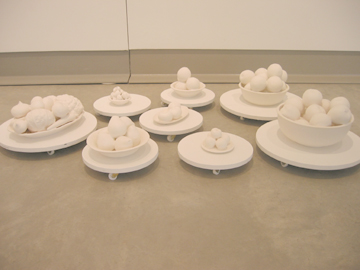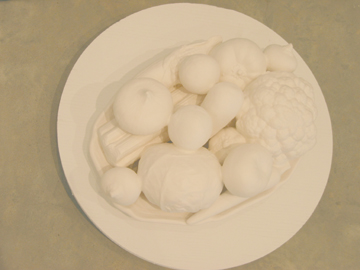Adrian Esparza
Curated by Kate Bonansinga
January 29 – March 6, 2004
Adrian Esparza currently lives and works in El Paso, TX where he was born in 1970. In 1996, he received a BFA from the University of Texas at El Paso, and then graduated in 1998 with an MFA from the California Institute for the Arts. In 2003, he was included in the Texas Trialogues: San Antonio - El Paso - Denton exhibition at the Blue Star Art Space, San Antonio, TX as well as Come Forward: Emerging Artists in Texas at the Dallas Museum of Art, TX. In 2002, Esparza participated in the Border Art Residency Program, La Union in New Mexico. He currently teaches Design and Drawing at the University of Texas at El Paso, Design and Art Appreciation at El Paso Community College and Drawing at the El Paso Museum of Art.
Kate Bonansinga is the Director of University Art Galleries at the University of Texas at El Paso. Bonansinga earned a B.A. in Economics from the University of Michigan, Ann Arbor and an M.A. in Art History, with a focus on the art of Asia, from the University of Illinois, Urbana-Champaign. From 1991-1999 she taught art history at the Oregon College of Art and Craft in Portland, Oregon, where she also served as director and curator of the College's exhibition gallery. There she developed an interest in contemporary art that resides at the intersection of materials-oriented fine craft and concept-driven fine art. Her most recent curatorial projects have focused on the art of the U.S./Mexico borderlands, including Crossing Over: Photographs and New Video Installations by Willie Varela, which is traveling throughout Texas. She serves on the editorial advisory board for ArtliesMagazine, Houston, TX and as a national art peer for the Office of the Chief Architect of the United States.
ARTIST'S STATEMENT
Rococococo
By constructing an environment of production, the object contributes to the development of an event. Entering this space causes the object to fracture. Evaluation fragments the fragile item. Particles existing in this restless environment unite to form acceptable interpretations of events. These notions emerge as fresh forms that reflect the migratory process of production.
CURATOR'S STATEMENT
by Kate Bonansinga
Adrian Esparza's Notions 256-189
Juarez, Mexico and El Paso, Texas together comprise the most densely populated bi-national area in the world. The bridge across the Rio Grande River that divides the two cities is short: many residents of Juarez commute daily to El Paso, and visa versa. While the international border is permeable, it also clarifies the socioeconomic inequalities that characterize both contemporary urban environments and the relationship between the U.S. and Mexico.
Adrian Esparza was born and raised in El Paso and returned here to live soon after earning his graduate degree. He garners much of his source material and artistic inspiration from his borderland experience, and the artist's daily encounter with this political divide seems to nourish his perpetual challenge of generally accepted boundaries and hierarchies. In Trade and Sell, for example, Esparza mounts to the wall an inexpensive Mexican blanket that he purchased from the market in Juarez. He then unravels its bottom portion, and guides the piece of cotton thread through a maze of nails affixed to the wall nearby to create a design that complements that of the blanket. It also alludes to hard-edged, geometric painting, though the soft texture of the material counter balances the linearity of the forms. By displaying the blanket as fine art, Esparza sanctifies this popular Mexican product. The act of its deconstruction and reconstruction references the dependence of present forms on past ones, and suggests new life and possibilities.
This concept also underlies Esparza's ceramic sculptures. For these he casts liquid clay into hobbyist molds, disassembles the resulting objects before the clay is completely dry, and then reassembles the parts into surreal works representing odd combinations of plants, animals and other organic matter. InCome and See, for example, a human head sprouts from a rabbit's neck. In Nature and Nurture, a flower blossom replaces the face of a seated boy. Esparza presents several of his sculptures in groupings. For one he gathers small pieces into a basket, transforming them into a centerpiece or three-dimensional still life. In another, the sculptures line up on a narrow platform mounted directly onto casters, and thus suggest both community and ease of movement. Displayed at ankle height, they upset the traditional eye-level encounter between viewer and artwork. All of the sculptures are raw white, pale counterparts to the vibrantly colored blankets, their smooth, monochromatic surfaces well suited to their complex forms. Esparza grafts together typically unrelated images to make art from the things and events of everyday life.
Esparza's painting on bed sheets are a third component in this body of work. For these the artist photocopies one of his drawings onto a transparency, projects the rendering onto a wall-mounted, full-sized, white bed sheet, and then traces the transmitted image in black fabric paint. Machine parts, smoke stacks and human figures crowd together, morph into one another, evolve into themselves, and almost completely consume their backdrop. The now-defunct copper smelter that towers over the western edge of El Paso inspires the industrial imagery. The painting's graphic renderings connote both comic books and patterned textiles. Considered together, the bed sheets and blankets speak of protection, warmth, sleep and dreams, and connect the imagery to subconscious thoughts and yearnings.
In all of these works, Esparza imbues the materials and processes of the decorative and popular arts with conceptual potency. His methodologies and titles suggest that opposites come together in a passing from one place, time and state of mind to another. The artist refers to his ideas as "notions," lending them a sense of chance and superstition, and numbers them in reverse, like anonymous products of descending dates or importance. But the art work that results from these "notions" is much more than ordinary because Esparza alters and assembles commonplace objects so that they become something greater than themselves.
View CATALOGUE
YOUNG ART CRITICS:




